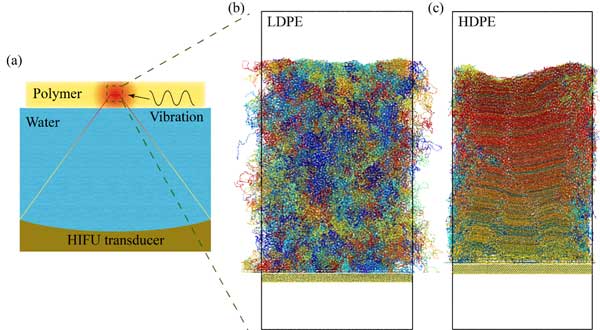| Oct 20, 2020 | |
Ultrasound-induced polymers |
|
| (Nanowerk Spotlight) Researchers from Virginia Tech's Future Materials Laboratory and MInDS Laboratory have recently demonstrated that high-intensity focused ultrasound (HIFU) is a promising, non-invasive stimulus with multiple superior and unique capabilities to induce localized heating and achieve temporal and spatial thermal effects in polymers. | |
| The team proposes a new manner of stimulating stimuli-responsive polymers. These polymers demonstrate promise for controlled drug delivery, sensing and biosensing, smart coatings, soft robotics, and flexible electronics among others. | |
| Accordingly, the capacity to manipulate these polymers is well sought after, but has proved challenging due to issues with the stimuli used to manipulate the polymers. | |
| Traditionally such polymers have been stimulated via direct heat, but this can damage heat-sensitive materials. Other techniques including irradiation, electric currents, and magnetic fields have also been used. Such techniques, however, reduce the efficiency of the polymer’s responsiveness. | |
| This recent study (Nanotechnology, "Interaction of High-Intensity Focused Ultrasound with Polymers at the Atomistic Scale") has demonstrated that these polymers can be stimulated by high frequency ultrasound (HIFU), which may bypass a variety of the issues precipitated by other techniques. | |
| HIFU transmits and focuses sound from a transducer into a small focal point. These sound waves interact with polymer chains in a select area, vibrating them and causing significant local heating effects necessary to stimulate the polymer, while leaving the surrounding area largely unaffected. | |
| The energy from the HIFU waves is both translated into dissipated heat and elastic deformation of the polymer chains. | |
 |
|
| Schematics for high-intensity ultrasound focusing, and molecular dynamic simulation of low-density polyethylene and high-density polyethylene (Image: Virginia Tech) (click on image to enlarge) | |
| Whereas conventional heating produces largely uniform changes in polymers, HIFU confers different thermal effects. This may be due to the different internal frictions of macromolecular chains. The particle velocity distribution and material thickness have been found to be responsible for the different heating effects. Experiments suggest that a range of factors are responsible for the ultrasound induced changes in polymers. | |
| Experiments have proved insufficient for establishing the range of effects caused by ultrasound on polymers, due to the low granularity provided by such experiments. Instead, computer modeling has been used to track the changes in polymers caused by HIFU heating. | |
| Molecular dynamics (MD) models allow scientists to study the mechanical and thermal properties of polymers, as every atom in the system can be recorded alongside the evolution of the chain orientation. | |
| This recent study investigated the ultrasound-induced thermal effects at the atomistic scale by MD stimulation. The team performed experiments to galvanize their computer models, with a focus on chain arrangement and structure in response to thermal effects. Low and high-density polyethylene (LDPE and HDPE respectively) were studied as counterparts. | |
| This is the first study to explore the ultrasound-induced thermal effects on polymers at the atom scale, which explains the observed responses at the macroscale. | |
| The experiments found that under focused ultrasounds with equal power, the heating rate of amorphous LDPE is larger than that of crystalline HDPE. MD simulations were used to elucidate the mechanisms of this difference. The scientists examined tha mechanisms at different scales. At the larger system level, the frequency-dependent viscoelasticity is the direct factor. At the molecular chain level the thermal motion of chains is greater in LDPE than it is in HDPE. Indications suggest that at the atom level, LDPE atoms are more flexible than those in HDPE. | |
| As the field of polymer manipulation continues to expand, new manners of manipulating polymers are of paramount importance for propelling the discipline. The novel research into HIFU manipulation of polymers opens the door for further developments, and allows future researchers to use similar modelling systems when investigating polymeric effects. | |
| A Nanowerk exclusive by Jack Seaberry. Jack is a technical writer from the University of Victoria. | |
|
Become a Spotlight guest author! Join our large and growing group of guest contributors. Have you just published a scientific paper or have other exciting developments to share with the nanotechnology community? Here is how to publish on nanowerk.com. |
|
